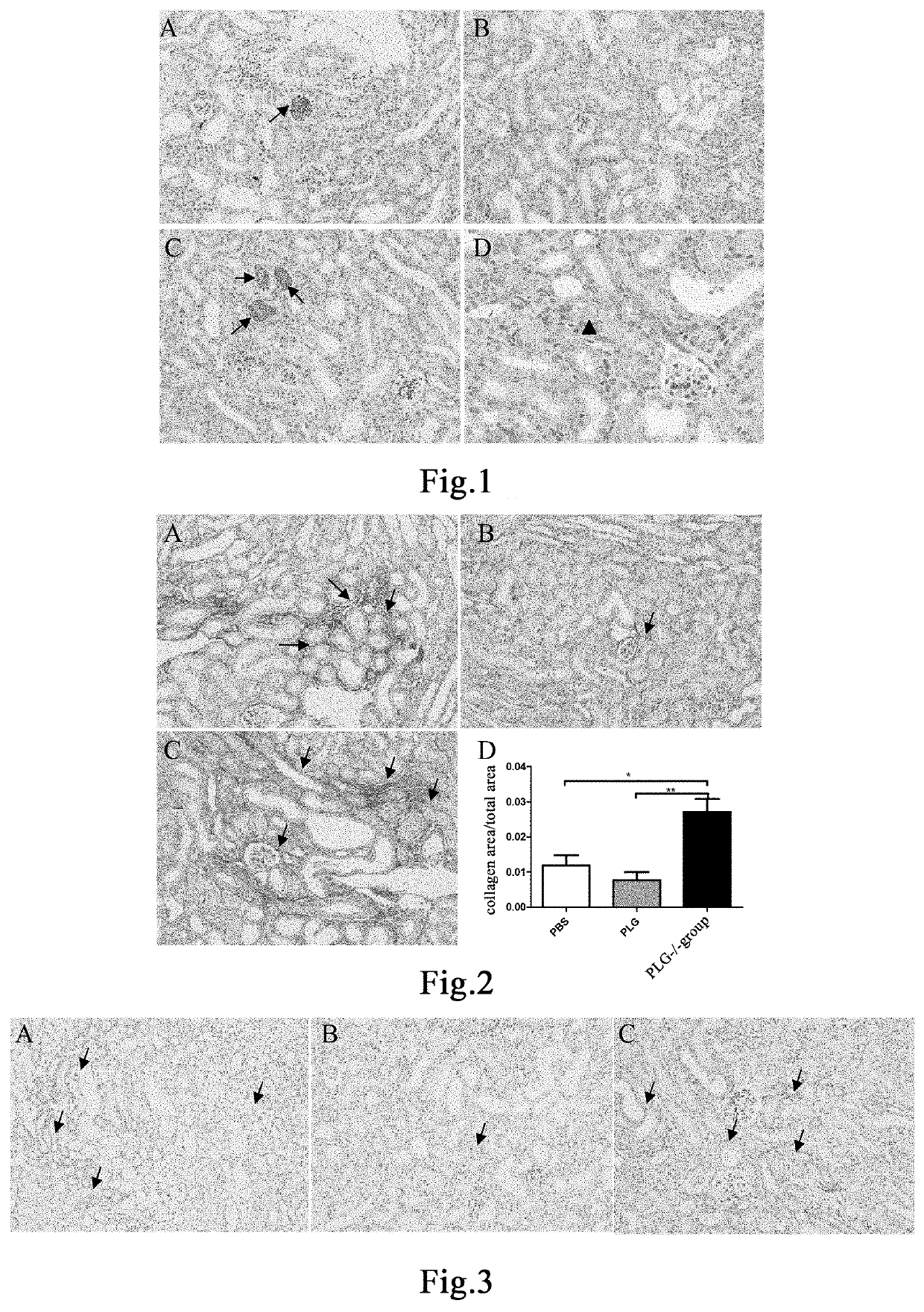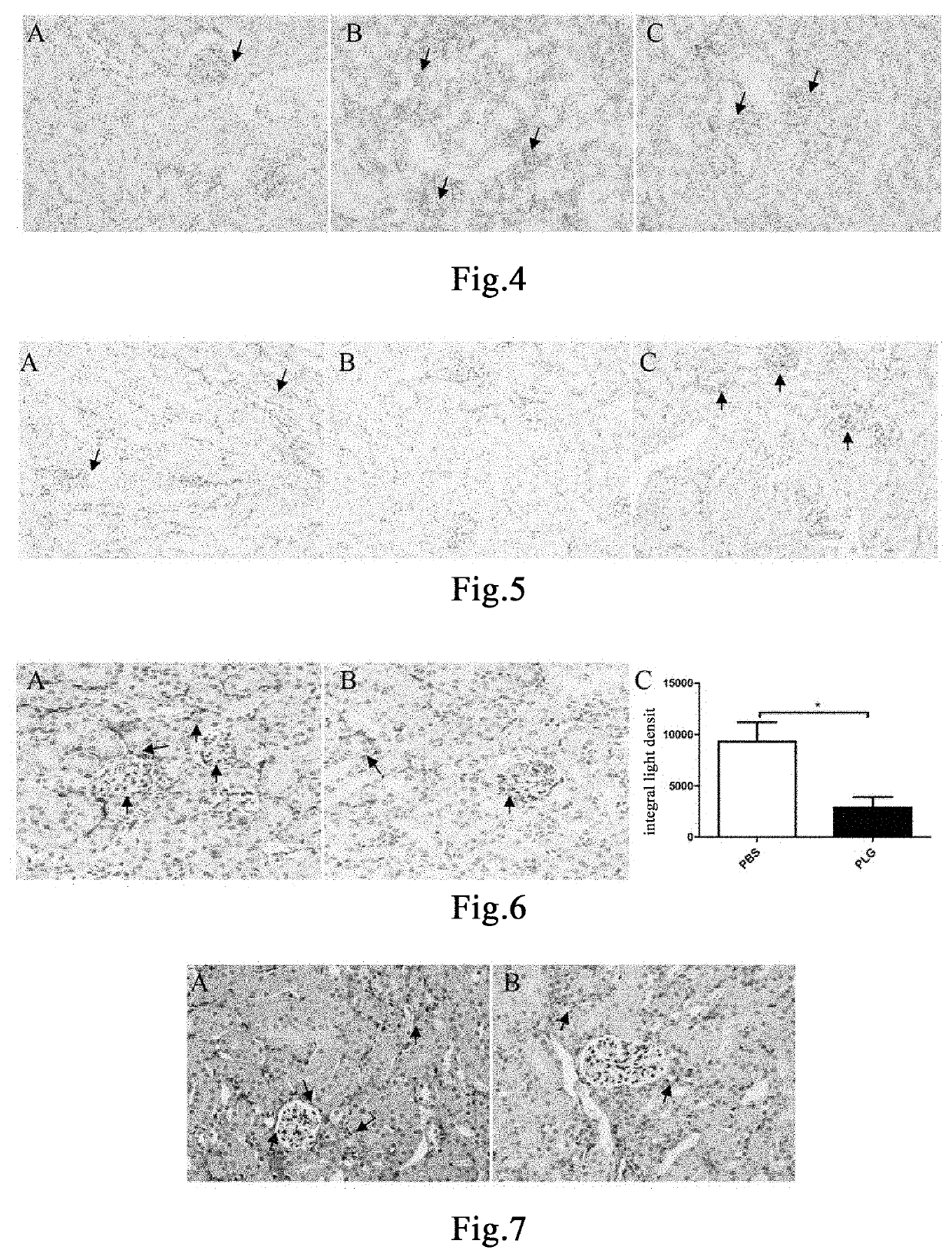Method for preventing and treating pathological renal tissue injury
a technology of pathological renal tissue injury and plasminogen, which is applied in the direction of enzymology, drug composition, peptide/protein ingredients, etc., can solve the problems of affecting the function of renal tissue, prolonged hypertension can affect more and more tissues and organs, and mortality and disability of diabetic patients, so as to prevent and/or treat renal tissue injury
- Summary
- Abstract
- Description
- Claims
- Application Information
AI Technical Summary
Benefits of technology
Problems solved by technology
Method used
Image
Examples
example 1
Plasminogen Protects the Kidney in a Chronic Renal Injury Model
[0158]Twenty 8- to 9-week-old PLG+ / + mice and six PLG− / − mice were taken. PLG+ / + mice were randomly divided into two groups, 10 mice in each of the group administered with plasminogen and the control group administered with vehicle PBS. Mice in the group administered with plasminogen, the control group administered with vehicle PBS, and the PLG− / − group were fed with a 0.25% purine diet (Nantong TROPHIC) every day to establish the chronic renal injury model [26]. The day of model establishment was recorded as Day 1, and administration began at the same time. Mice in the group administered with plasminogen were administered with plasminogen at a dose of 1 mg / 0.1 mL / mouse / day via the tail vein, and an equal volume of PBS was administered to mice in the control group administered with vehicle PBS in the same manner, both lasting for 10 consecutive days for model establishment. PLG− / − mice were not treated. The mice were sac...
example 2
Plasminogen Repairs Renal Fibrosis in a Chronic Renal Injury Model
[0160]Twelve 8- to 9-week-old male PLG+ / + mice and six PLG− / − mice were taken. PLG+ / + mice were randomly divided into two groups, 6 mice in each of the group administered with plasminogen and the control group administered with vehicle PBS. The modelling method for the chronic renal injury model was the same as described in Example 1. The day of model establishment was recorded as Day 1, and administration began at the same time. Mice in the group administered with plasminogen were administered with plasminogen at a dose of 1 mg / 0.1 mL / mouse / day via the tail vein, and an equal volume of PBS was administered to mice in the control group administered with vehicle PBS in the same manner, both lasting for 10 consecutive days for model establishment. PLG− / − mice were not treated. The mice were sacrificed on Day 11. The kidneys were fixed in 4% paraformaldehyde for 24 hours. The fixed kidneys were paraffin-embedded after de...
example 3
Plasminogen Promotes the Expression of Apoptosis Inhibitory Protein Bcl-2 in Kidneys of Mice Having a Chronic Renal Injury
[0163]Eighteen 8- to 9-week-old male PLG+ / + mice were randomly divided into three groups, 6 mice in each of the blank control group, the group administered with plasminogen, and the control group administered with vehicle PBS. The modelling method for the chronic renal injury model was the same as described in Example 1. The day of model establishment was recorded as Day 1, and administration began at the same time. The blank control group was fed with a normal maintenance diet. Mice in the group administered with plasminogen were administered with plasminogen at a dose of 1 mg / 0.1 mL / mouse / day via the tail vein, and an equal volume of PBS was administered to mice in the control group administered with vehicle PBS in the same manner, both lasting for 10 consecutive days for model establishment. Mice in the blank control group received no treatment. The day of mod...
PUM
| Property | Measurement | Unit |
|---|---|---|
| period of time | aaaaa | aaaaa |
| thick | aaaaa | aaaaa |
| thickness | aaaaa | aaaaa |
Abstract
Description
Claims
Application Information
 Login to View More
Login to View More - R&D
- Intellectual Property
- Life Sciences
- Materials
- Tech Scout
- Unparalleled Data Quality
- Higher Quality Content
- 60% Fewer Hallucinations
Browse by: Latest US Patents, China's latest patents, Technical Efficacy Thesaurus, Application Domain, Technology Topic, Popular Technical Reports.
© 2025 PatSnap. All rights reserved.Legal|Privacy policy|Modern Slavery Act Transparency Statement|Sitemap|About US| Contact US: help@patsnap.com



